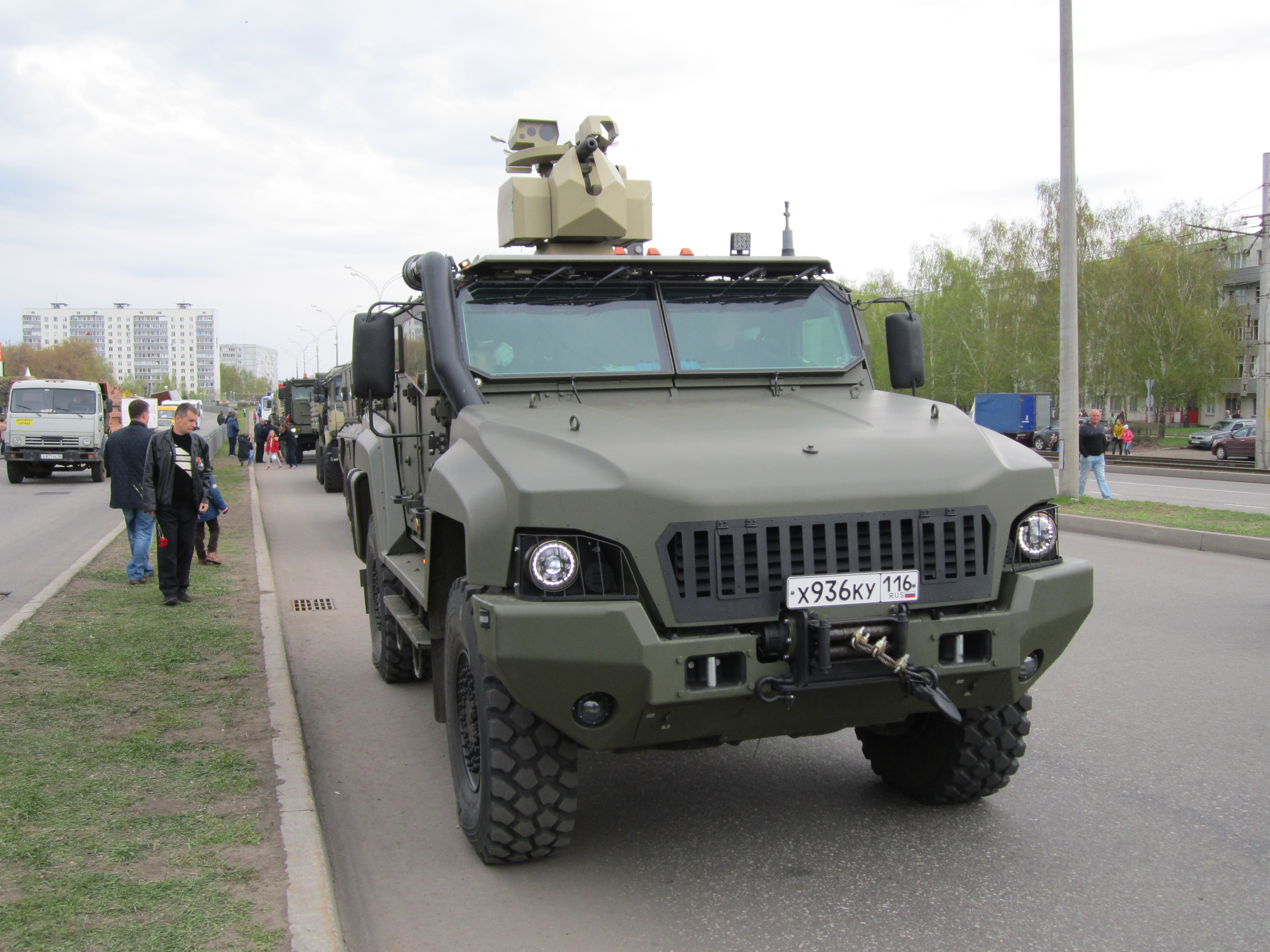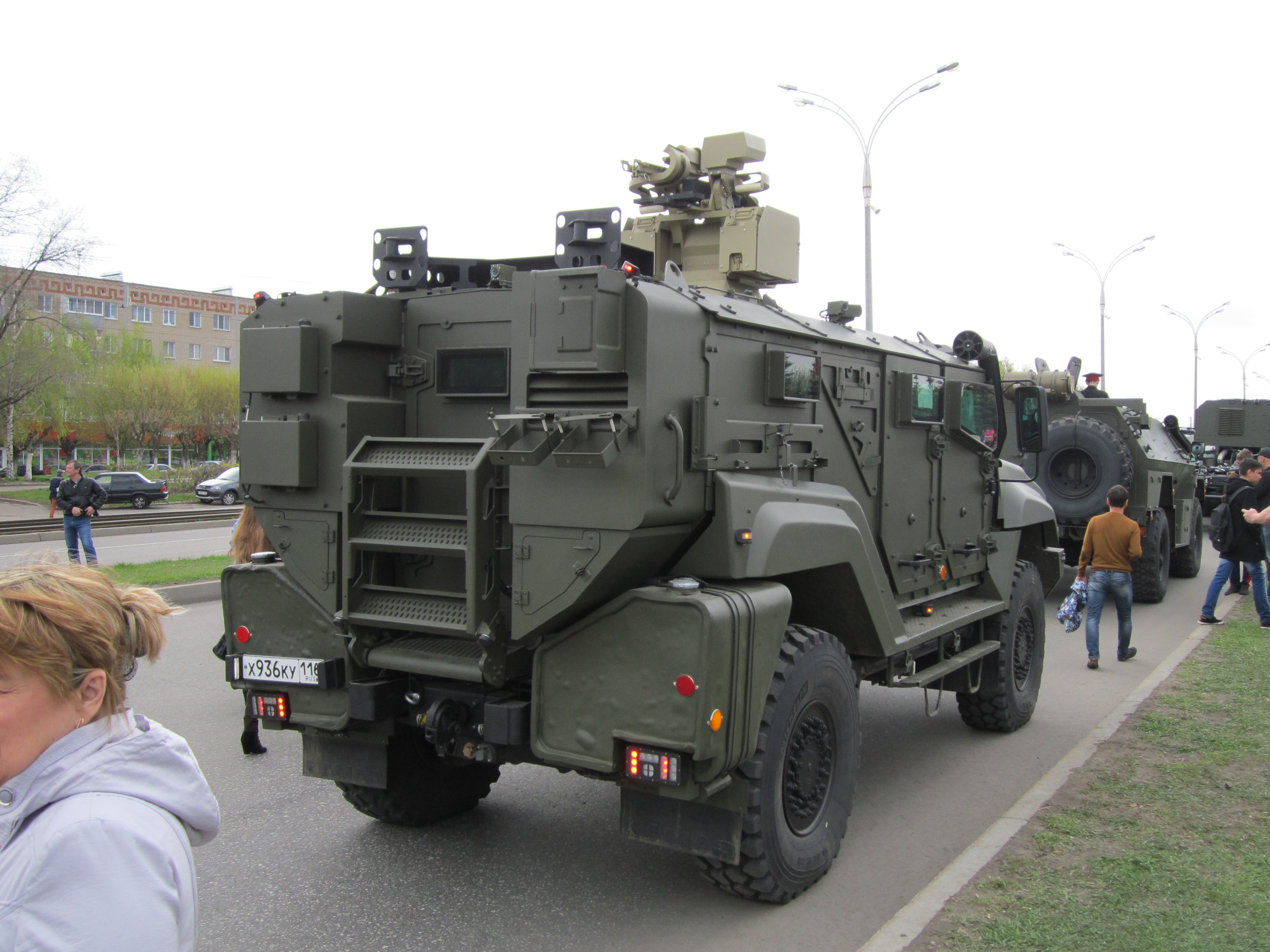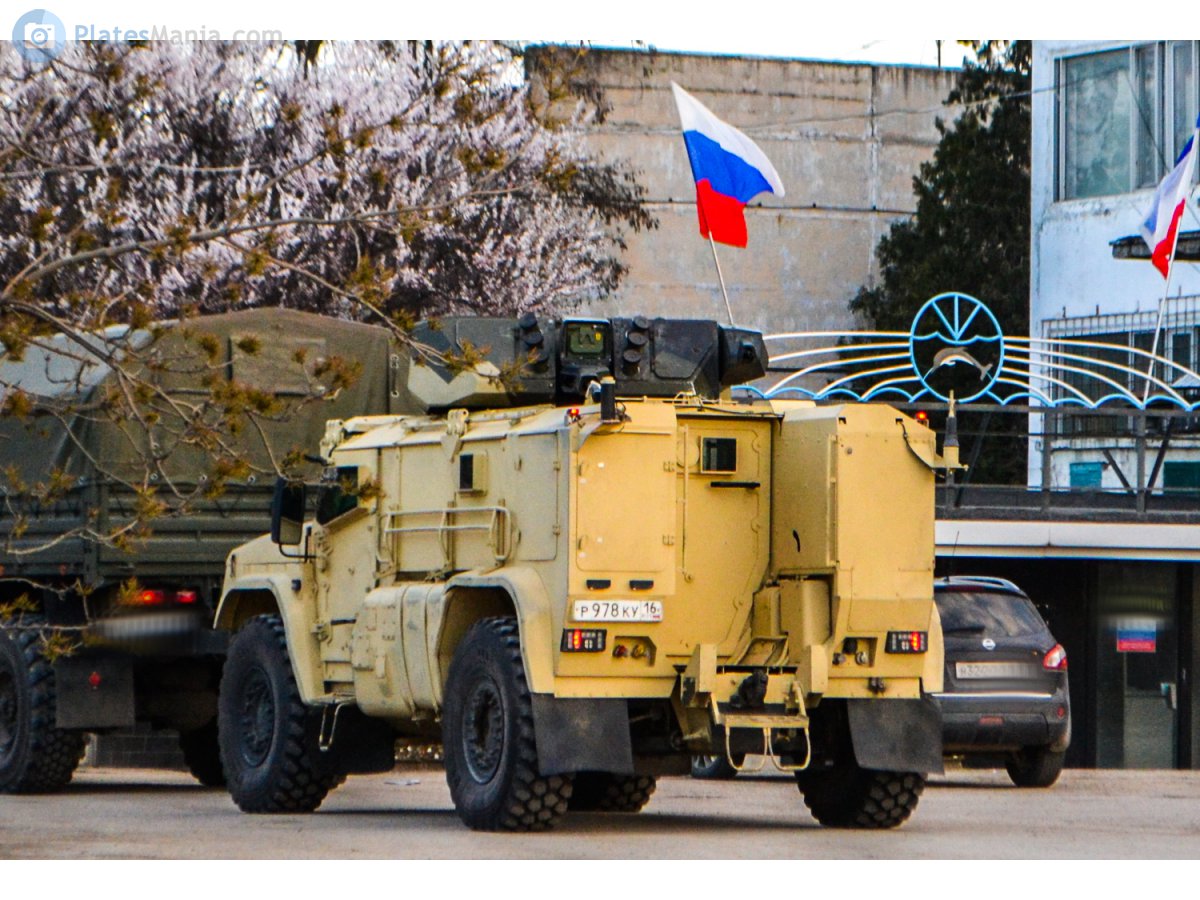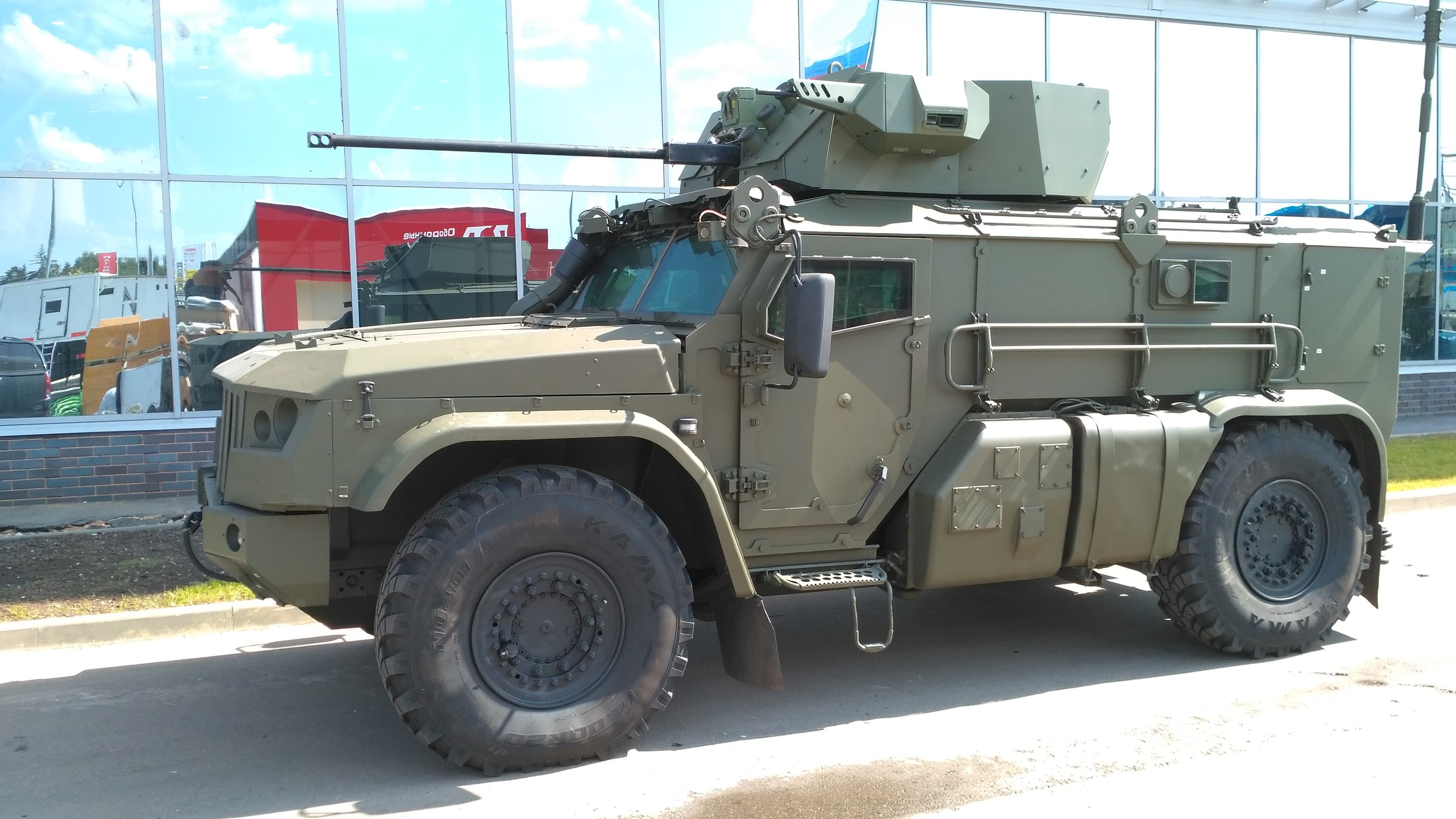


 Re: Typhoon MRAP family vehicles
Re: Typhoon MRAP family vehicles


 Re: Typhoon MRAP family vehicles
Re: Typhoon MRAP family vehicles
 Re: Typhoon MRAP family vehicles
Re: Typhoon MRAP family vehicles Re: Typhoon MRAP family vehicles
Re: Typhoon MRAP family vehiclesfranco wrote:The principal decision to develop projects for similar army trucks in Russia was made in 2010, when the Concept for the Development of Military Automotive Equipment of the Armed Forces of the Russian Federation for the Period to 2020 was approved. The Typhoon family managed to create in the shortest possible time, thanks to the joint efforts of more than 120 enterprises. The decisive contribution was made by the Kamsky and Ural automobile factories, which presented the armored cars "Typhoon-K" and "Typhoon-U" respectively. For the first time these machines were presented to the public in 2014 at the Victory Parade in Moscow.
Different approaches
The armored vehicles of the family are unified by engines, information-control system, mine protection and suspension. They can be installed remotely controlled machine gun module. Combined armor (ceramics and steel), as well as armored glass, provide round protection for Typhoons from all types of small arms ammunition up to 14.5 mm armor-piercing bullets B-32. Both machines are capable of withstanding explosion under the bottom of an explosive device up to eight kilograms in TNT equivalent. This is more than enough to protect against most modern anti-tank mines.
"Typhoons" are able to reach speeds of up to 105 kilometers per hour. The range of travel on one tank is up to 1400 kilometers: twice as much as in the case of old men of Ural-375. Both cars are made according to the 6x6 formula and have an independent hydropneumatic suspension, which allows to change the ground clearance, and can carry 16 people each. In the cockpit and amphibious units of the "Typhoons" there are multifunction displays, which display images from external cameras, night vision devices and remotely controlled weapons.
Both "Typhoon" in general are equivalent and comparable in their tactical and technical characteristics. The difference is only in the layout. Manufacturers remained true to their own approaches: "Typhoon-K" is traditionally used for KamAZ cars in a no-hood scheme. In turn, "Typhoon-U", like all the "Urals", the hood has. A high level of unification makes it possible to collect for the needs of the Armed Forces two identical machines at different plants, without reorganizing their production lines. We see something similar in military aircraft building. The Ministry of Defense buys for the needs of the military security corps comparable in their capabilities fighters Su-30SM and Su-35S. The first are produced in Irkutsk, the latter - in Komsomolsk-on-Amur. The purchase of two types of aircraft allows the loading of both plants by orders and eventually increases the number of new fighters entering the troops.
To date, there are about 180 units of the Typhoon-U and 260 Typhoon-K vehicles in the fleet of the Russian Armed Forces. The latter were used by Russian sappers in Syria during the demining of cities liberated from terrorists. In the future plans of the Ministry of Defense - the purchase of new lots of "Typhoons". The troops need not hundreds, but thousands of similar machines. Most likely, most of the supplies will go to the State Program of Armaments for 2018-2025.
EDIT: more units active then I thought
 Re: Typhoon MRAP family vehicles
Re: Typhoon MRAP family vehicleseehnie wrote:franco wrote:The principal decision to develop projects for similar army trucks in Russia was made in 2010, when the Concept for the Development of Military Automotive Equipment of the Armed Forces of the Russian Federation for the Period to 2020 was approved. The Typhoon family managed to create in the shortest possible time, thanks to the joint efforts of more than 120 enterprises. The decisive contribution was made by the Kamsky and Ural automobile factories, which presented the armored cars "Typhoon-K" and "Typhoon-U" respectively. For the first time these machines were presented to the public in 2014 at the Victory Parade in Moscow.
Different approaches
The armored vehicles of the family are unified by engines, information-control system, mine protection and suspension. They can be installed remotely controlled machine gun module. Combined armor (ceramics and steel), as well as armored glass, provide round protection for Typhoons from all types of small arms ammunition up to 14.5 mm armor-piercing bullets B-32. Both machines are capable of withstanding explosion under the bottom of an explosive device up to eight kilograms in TNT equivalent. This is more than enough to protect against most modern anti-tank mines.
"Typhoons" are able to reach speeds of up to 105 kilometers per hour. The range of travel on one tank is up to 1400 kilometers: twice as much as in the case of old men of Ural-375. Both cars are made according to the 6x6 formula and have an independent hydropneumatic suspension, which allows to change the ground clearance, and can carry 16 people each. In the cockpit and amphibious units of the "Typhoons" there are multifunction displays, which display images from external cameras, night vision devices and remotely controlled weapons.
Both "Typhoon" in general are equivalent and comparable in their tactical and technical characteristics. The difference is only in the layout. Manufacturers remained true to their own approaches: "Typhoon-K" is traditionally used for KamAZ cars in a no-hood scheme. In turn, "Typhoon-U", like all the "Urals", the hood has. A high level of unification makes it possible to collect for the needs of the Armed Forces two identical machines at different plants, without reorganizing their production lines. We see something similar in military aircraft building. The Ministry of Defense buys for the needs of the military security corps comparable in their capabilities fighters Su-30SM and Su-35S. The first are produced in Irkutsk, the latter - in Komsomolsk-on-Amur. The purchase of two types of aircraft allows the loading of both plants by orders and eventually increases the number of new fighters entering the troops.
To date, there are about 180 units of the Typhoon-U and 260 Typhoon-K vehicles in the fleet of the Russian Armed Forces. The latter were used by Russian sappers in Syria during the demining of cities liberated from terrorists. In the future plans of the Ministry of Defense - the purchase of new lots of "Typhoons". The troops need not hundreds, but thousands of similar machines. Most likely, most of the supplies will go to the State Program of Armaments for 2018-2025.
EDIT: more units active then I thought
The production going fast. It is logical. These machines had not troubles with the tests, and are in fact the wheeled light platform in the future Russian Armed Forces (with the BMD-4M being the light tracked platform). Smaller alternatives are having problems with the tests and this is not a good sign. Being smaller obviously have lower protection and lower capacity of troops, but also taking engines of less power, they have not advantage on mobility. I expect Russia to move on with the Typhoons 6x6 and to go forward with high levels of standardization.
I do not see room for the smaller projects as combat vehicles. In my opinion, if an air-droppable variant is needed, it should be developed from the typhoon 6x6 platform.
Likely the alone option for smaller vehicles in the Russian Armed Forces is for the roles of auxiliary vehicles (transport, light utility, some engineering role,...) to work outside of the contested areas, and for it they have to compete with the current range of vehicles in production (UAZ 469, Ural 4320, Kamaz 4310, Kamaz 4350, GAZ Tigr and UAZ Patriot) present in the Russian Armed Forces.
 Re: Typhoon MRAP family vehicles
Re: Typhoon MRAP family vehiclesmiketheterrible wrote:eehnie wrote:franco wrote:The principal decision to develop projects for similar army trucks in Russia was made in 2010, when the Concept for the Development of Military Automotive Equipment of the Armed Forces of the Russian Federation for the Period to 2020 was approved. The Typhoon family managed to create in the shortest possible time, thanks to the joint efforts of more than 120 enterprises. The decisive contribution was made by the Kamsky and Ural automobile factories, which presented the armored cars "Typhoon-K" and "Typhoon-U" respectively. For the first time these machines were presented to the public in 2014 at the Victory Parade in Moscow.
Different approaches
The armored vehicles of the family are unified by engines, information-control system, mine protection and suspension. They can be installed remotely controlled machine gun module. Combined armor (ceramics and steel), as well as armored glass, provide round protection for Typhoons from all types of small arms ammunition up to 14.5 mm armor-piercing bullets B-32. Both machines are capable of withstanding explosion under the bottom of an explosive device up to eight kilograms in TNT equivalent. This is more than enough to protect against most modern anti-tank mines.
"Typhoons" are able to reach speeds of up to 105 kilometers per hour. The range of travel on one tank is up to 1400 kilometers: twice as much as in the case of old men of Ural-375. Both cars are made according to the 6x6 formula and have an independent hydropneumatic suspension, which allows to change the ground clearance, and can carry 16 people each. In the cockpit and amphibious units of the "Typhoons" there are multifunction displays, which display images from external cameras, night vision devices and remotely controlled weapons.
Both "Typhoon" in general are equivalent and comparable in their tactical and technical characteristics. The difference is only in the layout. Manufacturers remained true to their own approaches: "Typhoon-K" is traditionally used for KamAZ cars in a no-hood scheme. In turn, "Typhoon-U", like all the "Urals", the hood has. A high level of unification makes it possible to collect for the needs of the Armed Forces two identical machines at different plants, without reorganizing their production lines. We see something similar in military aircraft building. The Ministry of Defense buys for the needs of the military security corps comparable in their capabilities fighters Su-30SM and Su-35S. The first are produced in Irkutsk, the latter - in Komsomolsk-on-Amur. The purchase of two types of aircraft allows the loading of both plants by orders and eventually increases the number of new fighters entering the troops.
To date, there are about 180 units of the Typhoon-U and 260 Typhoon-K vehicles in the fleet of the Russian Armed Forces. The latter were used by Russian sappers in Syria during the demining of cities liberated from terrorists. In the future plans of the Ministry of Defense - the purchase of new lots of "Typhoons". The troops need not hundreds, but thousands of similar machines. Most likely, most of the supplies will go to the State Program of Armaments for 2018-2025.
EDIT: more units active then I thought
The production going fast. It is logical. These machines had not troubles with the tests, and are in fact the wheeled light platform in the future Russian Armed Forces (with the BMD-4M being the light tracked platform). Smaller alternatives are having problems with the tests and this is not a good sign. Being smaller obviously have lower protection and lower capacity of troops, but also taking engines of less power, they have not advantage on mobility. I expect Russia to move on with the Typhoons 6x6 and to go forward with high levels of standardization.
I do not see room for the smaller projects as combat vehicles. In my opinion, if an air-droppable variant is needed, it should be developed from the typhoon 6x6 platform.
Likely the alone option for smaller vehicles in the Russian Armed Forces is for the roles of auxiliary vehicles (transport, light utility, some engineering role,...) to work outside of the contested areas, and for it they have to compete with the current range of vehicles in production (UAZ 469, Ural 4320, Kamaz 4310, Kamaz 4350, GAZ Tigr and UAZ Patriot) present in the Russian Armed Forces.
May I ask your sources? The 4x4 MRAPS from Kamaz are being tested in Syria. So far, everything seems to be smooth sailing for it. Actually, such system seems to be ideal for future of Russia's wheeled vehicles. Although it seems Tiger-M is getting preferential treatment for some reason. Maybe due to being lighter and could be used as a good system for border guards.
 Re: Typhoon MRAP family vehicles
Re: Typhoon MRAP family vehicles Re: Typhoon MRAP family vehicles
Re: Typhoon MRAP family vehiclesmiketheterrible wrote:Initially. The first system you mentioned isn't actually being developed anymore and the rest are simply systems leftover and being used. The Typhoon 4x4 I have not heard anything regarding problems, at least not since the first initial system was created years ago. So I am not sure what you are referring to. The Vystral and the like are systems known to have issues long ago so that is understandable. If Typhoon 4x4 shares the same as the 6x6 then there shouldn't be any issues except for possible structural issues due to less amount of tires and needed suspension. Distribution of the weight. But that should not be an issue due to the scaling down of size.
Care to share the sources?
The KamAZ-53949 is a Russian mine resistant ambush protected vehicle (MRAP). It is nicknamed the Taifunionok. This vehicle was developed by KamAZ as a private venture to meet a possible Russian Army requirement. Development commenced somewhere in 2010. This mine resistant vehicle was first publicly revealed in 2013. Testing of this vehicle was planned to be completed in 2015. However in 2014 it has been reported that this vehicle will not be produced for the Russian armed forces, due to sanctions imposed on Russia. It appeared that the KamAZ-53949 uses a large number of Western components. These are either directly supplied from the West, or are license-produced locally. Still though in 2016 it was announced that since 2017 this mine protected vehicle will be marketed internationally.
 Re: Typhoon MRAP family vehicles
Re: Typhoon MRAP family vehicles Re: Typhoon MRAP family vehicles
Re: Typhoon MRAP family vehicles Re: Typhoon MRAP family vehicles
Re: Typhoon MRAP family vehicleseehnie wrote:In a few words, comparing the data of the Typhoon-K 6x6 and the Typhoon 4x4 we can see:
http://www.military-today.com/apc/kamaz_taifun.htm
http://www.military-today.com/apc/kamaz_53949.htm
- Being done with the same materials, the weight relation can be a good measure to see about protection of the crew. 75% more weight for the 6x6. Clear advantage on protection.
- The smaller should have an economic advantage, but is more apparent than real, because while the Typhoon 4x4 is designed for 2+8, the Typhoon 6x6 is designed for 2+16+. It means that more than 2 Typhoon 4x4 are needed to transport the same troops than one Typhoon-K 6x6. Also it means more than twice personel (and salaries) for crew of the vehicles needed to transport the same soldiers.
- Finally, also the smaller should have an advantage on mobility, but while the Typhoon-K 6x6 has an engine of 450hp, the Typhoon 4x4 has one of 350hp. 28.6% of advantage for the Typhoon-K. It kills most of the potential advantage on mobility for the smaller, as we can see comparing the maximum speed and the rest of the data about maneuverability. Only 16.7% advantage on speed for the Typhoon 4x4, and few more.
The result of all it is that the Typhoon 4x4 has nothing significant to offer vs the Typhoon 6x6 advantage on protection of the troops. As consequence, is not ordered for the Russian Armed Forces.
The problems of the smaller vehicles in the tests are almost always related with the protection of the crew and the troops moved.
 Re: Typhoon MRAP family vehicles
Re: Typhoon MRAP family vehiclesSeigSoloyvov wrote:eehnie wrote:In a few words, comparing the data of the Typhoon-K 6x6 and the Typhoon 4x4 we can see:
http://www.military-today.com/apc/kamaz_taifun.htm
http://www.military-today.com/apc/kamaz_53949.htm
- Being done with the same materials, the weight relation can be a good measure to see about protection of the crew. 75% more weight for the 6x6. Clear advantage on protection.
- The smaller should have an economic advantage, but is more apparent than real, because while the Typhoon 4x4 is designed for 2+8, the Typhoon 6x6 is designed for 2+16+. It means that more than 2 Typhoon 4x4 are needed to transport the same troops than one Typhoon-K 6x6. Also it means more than twice personel (and salaries) for crew of the vehicles needed to transport the same soldiers.
- Finally, also the smaller should have an advantage on mobility, but while the Typhoon-K 6x6 has an engine of 450hp, the Typhoon 4x4 has one of 350hp. 28.6% of advantage for the Typhoon-K. It kills most of the potential advantage on mobility for the smaller, as we can see comparing the maximum speed and the rest of the data about maneuverability. Only 16.7% advantage on speed for the Typhoon 4x4, and few more.
The result of all it is that the Typhoon 4x4 has nothing significant to offer vs the Typhoon 6x6 advantage on protection of the troops. As consequence, is not ordered for the Russian Armed Forces.
The problems of the smaller vehicles in the tests are almost always related with the protection of the crew and the troops moved.
If we go by your own link has fact then it even states the 4x4 will not be produced because Russia cannot manufacture it's parts.
 Re: Typhoon MRAP family vehicles
Re: Typhoon MRAP family vehicleseehnie wrote:It has been a work to offer them for export, by 2017 it should be producible. The part of the foreign components can be corregible, maybe corrected at this point, but still it will not make the vehicle competitibe with the Typhoon 6x6. The situation exposed in my previous comment is common to all the smaller vehicles.



 So currently Russian Military has 180 Typhoon-U and 260 Typhoon-K in stock with more to come.
So currently Russian Military has 180 Typhoon-U and 260 Typhoon-K in stock with more to come.
 Re: Typhoon MRAP family vehicles
Re: Typhoon MRAP family vehicles


MMBR likes this post

 Re: Typhoon MRAP family vehicles
Re: Typhoon MRAP family vehicles Re: Typhoon MRAP family vehicles
Re: Typhoon MRAP family vehicles
 Re: Typhoon MRAP family vehicles
Re: Typhoon MRAP family vehicles Re: Typhoon MRAP family vehicles
Re: Typhoon MRAP family vehicles


MMBR likes this post
 Re: Typhoon MRAP family vehicles
Re: Typhoon MRAP family vehicles Re: Typhoon MRAP family vehicles
Re: Typhoon MRAP family vehicles
 Re: Typhoon MRAP family vehicles
Re: Typhoon MRAP family vehicles Re: Typhoon MRAP family vehicles
Re: Typhoon MRAP family vehiclesfranco wrote:First of the new Typhoon-K 4 wheel IMV entered service;
https://bmpd.livejournal.com/2991916.html
 Re: Typhoon MRAP family vehicles
Re: Typhoon MRAP family vehicleseehnie wrote:franco wrote:First of the new Typhoon-K 4 wheel IMV entered service;
https://bmpd.livejournal.com/2991916.html
It seems to be units for testing with the Armed Forces, right?
 Re: Typhoon MRAP family vehicles
Re: Typhoon MRAP family vehicles